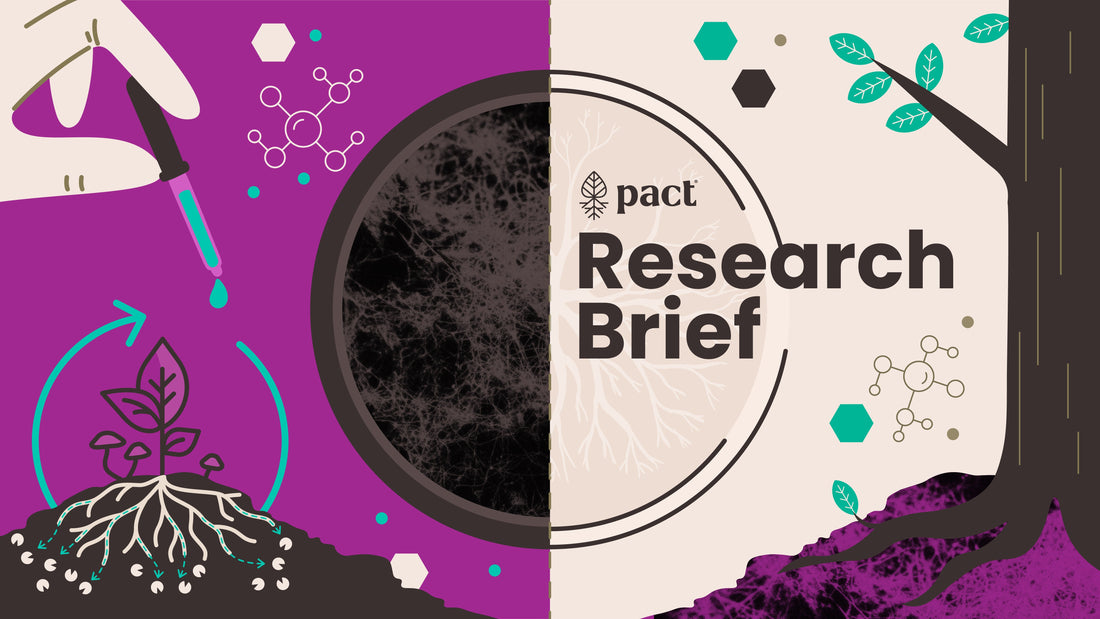
Stropharia Kills Pathogens In Poop
Share
The Backcountry Poop Problem
The microbes in the soil that help to decompose poop in the backcountry are often unable to keep up with buried or surface level human waste (Bridle and Kirkpatrick 2004). Why? Ecosystems, particularly across the U.S., have very different environmental conditions that impact soil microbe activity.
This variation has a range of impacts across ecosystems including:
- Bacterial pathogens in human poop can remain active in the soil for over a year (Goodwin et al. 2012).
- Fecal bacteria like E. coli in human waste contaminates waterways (Derlet et al. 2008) leading to gastrointestinal diseases and other issues (Boulware 2004).
- Animals can become habituated to human waste leading to behavioral changes (Daszak et al. 2000).
- Mis-handled poop can affect soil health via the nutrient cycling process (Craine et al. 2007).
In addition, the sight of improperly disposed human waste significantly reduces visitor satisfaction, even more so than overcrowding (USFS, 2020). Waste management is also one of the biggest expenses and resource issues affecting land managers and a major driver of increased regulations like closing of dispersed camping and reduction of backcountry permits. You can read more about the consequences of mis-handled human waste in our Research Brief, Why Use Mycelium To Break Down Poop In the Backcountry.
Using Mycelium & Mycoremediation To Decontaminate Soil
A growing body of work supports mycoremediation: the use of fungal mycelium for breaking down human waste (Harms 2011). Saprotrophic fungi like the species used in PACT Tabs are nature’s recyclers and upcyclers. They have unique potential to break down both organic and inorganic pollutants, converting them into bioavailable nutrients for the soil.
Different species of fungi from across the kingdom have been shown to break down various pollutants from explosives to pesticides and PCBs (Harms 2011). For example:
- The EPA funded work by Paul Stamets to investigate filtering out E. coli from water runoff using fungal mycelium (Stamets, 2013).
- Researchers at the University of New Mexico, together with the City of Albuquerque, used floating fungi filters to reduce pathogens from wastewater lagoons. They found that the filters reduced surface level E. coli reliably, week after week (Martinez, 2016).
- The Dungeness Watershed built a wetland to treat cow manure and incorporated a layer of mycelium (a trio of Pleurotus ostreatus, Pleurotus ulmarius, and Stropharia rugosoannulata) which helped to consistently remove E. coli.
Stropharia Rugosoannulata and Mycoremediation
Stropharia rugosoannulata, the species of fungi used in PACT Tabs, has been studied extensively for its potential for bioremediation of soils. S. rugosoannulata has the incredible ability to break down various environmental pollutants, not just organic matter, in both soil and water. Its lignin modifying enzymes (LME) for wood decomposition are not highly specialized (i.e. limited to wood), allowing them to degrade various other compounds as well.
For example, S. rugosoannulata is able to degrade “a wide range of structurally different environmental pollutants such as polycyclic aromatic hydrocarbons (PAHs), cancer-causing byproducts of fossil fuel burning (Pozdnyakova, et. al., 2018). White-rot fungi, which includes S. rugosoannulata, are also known to remove pharmaceutical-derived pollutants and antibiotics (both commonly found in human poop).
S. rugosoannulata is also extremely beneficial to soils. When used as a soil additive in forestlands, it is correlated with a consistently higher abundance of beneficial bacteria like Acidobacteria, Planctomycetes and Bacteroidetes that support the decomposition of organic matter, as well as carbon and nitrogen cycles. Saprotrophic fungi like S. rugosoannulata convert decaying organic matter as well as environmental pollutants into bioavailable nutrients that support the abundance and diversity of good soil bacteria (Gong, et. al., 2018).
Stropharia Rugosoannulata: Decomposition and Pathogen Reduction in Human Poop
Some of the compounds mentioned earlier are ever-present in human waste (as well as in toilet tissue), making S. rugosoannulata particularly well-suited for mycoremediation—the breakdown and treatment of human waste in backcountry settings. However, a central challenge remains: the presence of bacterial coliforms such as E. coli. As outlined in the introduction, E. coli and other coliform bacteria represent some of the most pressing concerns when managing human waste outdoors [(Goodwin et al., 2012; Derlet et al., 2008)].
Effective management depends on two factors: the rate of decomposition and the removal of pathogens. PACT partnered with two of the nation’s leading experts in mycology, mycoremediation, and environmental engineering—Tradd Cotter and Lauren Czaplicki. Our initial research focused on determining whether S. rugosoannulata could break down feces more effectively than other fungal species. These studies were conducted in both controlled laboratory conditions and real-world field environments.
In preliminary lab and field studies, S. rugosoannulata colonized and decomposed human waste more effectively than other fungal species. This isn’t necessarily surprising as S. rugosoannulata is a known nematophagous fungus, which means it hunts small, microscopic, worm-like creatures called nematodes similar to pathogens in human poop like E. coli. It hunts them by producing mace-like structures that immobilize and digest the prey. A similar mechanism is likely at play here allowing the mycelium to obtain energy from the microbes in human waste (Luo 2006).
When conducting our field experiments, we found that the S. rugosoannulata in PACT Tabs grew faster when the PACT Wipe was present in the hole with the human waste, indicating that the PACT Wipes acted as a sort of initial food source for the mycelium. Again, not necessarily surprising given the Wipe is wet, plant-based and fibrous - a similar food source to what this species would seek out in the wild.
In the second part of our lab study, we looked at S. rugosoannulata’s ability to remove coliform bacteria like E. coli. In the course of one day, S. rugosoannulata reduced E. coli by 75% when the PACT Wipe was present and by 58% in the samples with human waste alone. This was measured in CFUs/g or Colony-Forming Units per gram, a standard in microbiology for measuring viable bacteria in a sample.
This performance translated into a real use scenario in the field, as S. rugosoannulata decomposed human waste with the compressed PACT Wipe present by 66% in 30 days compared to 46% when the PACT Wipe was not present.
These positive results led to a partnership with Colorado Mountain College to continue to validate and document this with a formal academic-led, peer-reviewed study. The forthcoming study, funded by PACT Outdoors, found S. rugosoannulata-enhanced soil treatments had a mean E. coli reduction of -89.42%, while the control group (without mycelium) showed a mean increase in E. coli of +71.37%.


This difference in mean percent change provides strong evidence of S. rugosoannulata’s antibacterial properties, effectively reducing E. coli in concentrations of soil (Seitzinger 2025). Preliminary data from the study can be seen below. A peer-reviewed, published study will be shared in the months ahead.
Summary
These results demonstrate that Stropharia rugosoannulata functions as both an effective decomposer and an active reducer of bacterial pathogens in human waste. Across controlled laboratory conditions and field environments, S. rugosoannulata consistently accelerated the decomposition of fecal material and reduced concentrations of E. coli. These effects are likely mediated through its lignin-modifying enzyme systems and nematophagous mechanisms, which enable it to degrade a wide range of organic substrates. In addition, the fungus supports the proliferation of beneficial soil bacteria that contribute to essential carbon and nitrogen cycling, suggesting broader ecological benefits beyond just pathogen removal.
By utilizing S. rugosoannulata in PACT Tabs, we are leveraging nature’s own biological systems to close the loop on waste management—transforming a long-standing backcountry challenge into a regenerative process. This research underscores a broader vision: that innovation rooted in ecology can serve both people and public lands.
Bibliography
-
Boulware David R., Influence of Hygiene on Gastrointestinal Illness among Wilderness Backpackers, Journal of Travel Medicine, Volume 11, Issue 1, 1 January 2004, Pages 27–33, - LINK
-
Bridle KL, Kirkpatrick JB. An analysis of the breakdown of paper products (toilet paper, tissues and tampons) in natural environments, Tasmania, Australia. J Environ Manage. 2005 Jan;74(1):21-30. doi: 10.1016/j.jenvman.2004.08.004. PMID: 15572078. - LINK
-
Craine JM, Morrow C, Fierer N. Microbial nitrogen limitation increases decomposition. Ecology. 2007 Aug;88(8):2105-13. doi: 10.1890/06-1847.1. PMID: 17824441. - LINK
-
Daszak P, Cunningham AA, Hyatt AD. Emerging infectious diseases of wildlife--threats to biodiversity and human health. Science. 2000 Jan 21;287(5452):443-9. doi: 10.1126/science.287.5452.443. Erratum in: Science 2000 Mar 10;287(5459):1756. PMID: 10642539. - LINK
-
Derlet RW, Ali Ger K, Richards JR, Carlson JR. Risk Factors for Coliform Bacteria in Backcountry Lakes and Streams in the Sierra Nevada Mountains: A 5-Year Study. Wilderness & Environmental Medicine. 2008;19(2):82-90. doi:10.1580/07-WEME-OR-1511.1 - LINK
-
Gong S, Chen C, Zhu J, Qi G, Jiang S. 2018. Effects of wine-cap Stropharia cultivation on soil nutrients and bacterial communities in forestlands of northern China. PeerJ 6:e5741 - LINK
-
Goodwin, K., Loso, M. G., & Braun, M. (2012). Glacial Transport of Human Waste and Survival of Fecal Bacteria on Mt. McKinley’s Kahiltna Glacier, Denali National Park, Alaska. Arctic, Antarctic, and Alpine Research, 44(4), 432–445. - LINK
-
Harms H, Schlosser D, Wick LY. Untapped potential: exploiting fungi in bioremediation of hazardous chemicals. Nat Rev Microbiol. 2011 Mar;9(3):177-92. doi: 10.1038/nrmicro2519. Epub 2011 Feb 7. PMID: 21297669. - LINK
-
Luo H, Li X, Li G, Pan Y, Zhang K. 2006. Acanthocytes of Stropharia rugosoannulata function as a nematode-attacking device. Appl Environ Microbiol. 72(4):2982–2987. doi:10.1128/AEM.72.4.2982-2987.2006. - LINK
-
Martinez, Savannah E.. "E. Coli Removal by Pleurotus Ostreatus Mycofilter in Simulated Wet Environmental Pond." (2016) - LINK
-
Pozdnyakova, N., Schlosser, D., Dubrovskaya, E. et al. The degradative activity and adaptation potential of the litter-decomposing fungus Stropharia rugosoannulata. World J Microbiol Biotechnol 34, 133 (2018). - LINK
-
Seitzinger, S., Hasdelhorst, M. (2025). Mycoremediation in the Backcountry: Fungal Solutions for Escherichia coli-contaminated Soils. [Manuscript submitted for publication]. Department of Ecosystem Sciences, Colorado Mountain College.
- Stamets P., Marc Beutel, PhD., Alex Taylor, Alicia Flatt, Morgan Wolff, Katie Brownson. Mycofiltration Biotechnology for Pathogen Management. Fungi Perfecti’s EPA SBIR Phase I Research Results. 2013. - LINK
